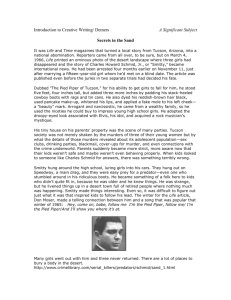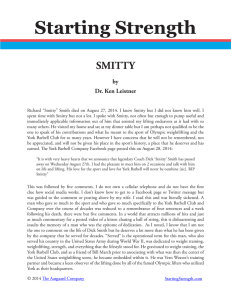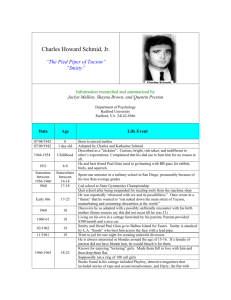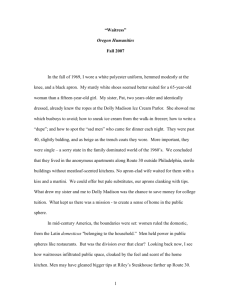Pied Piper of Tuscon - Davis School District
advertisement
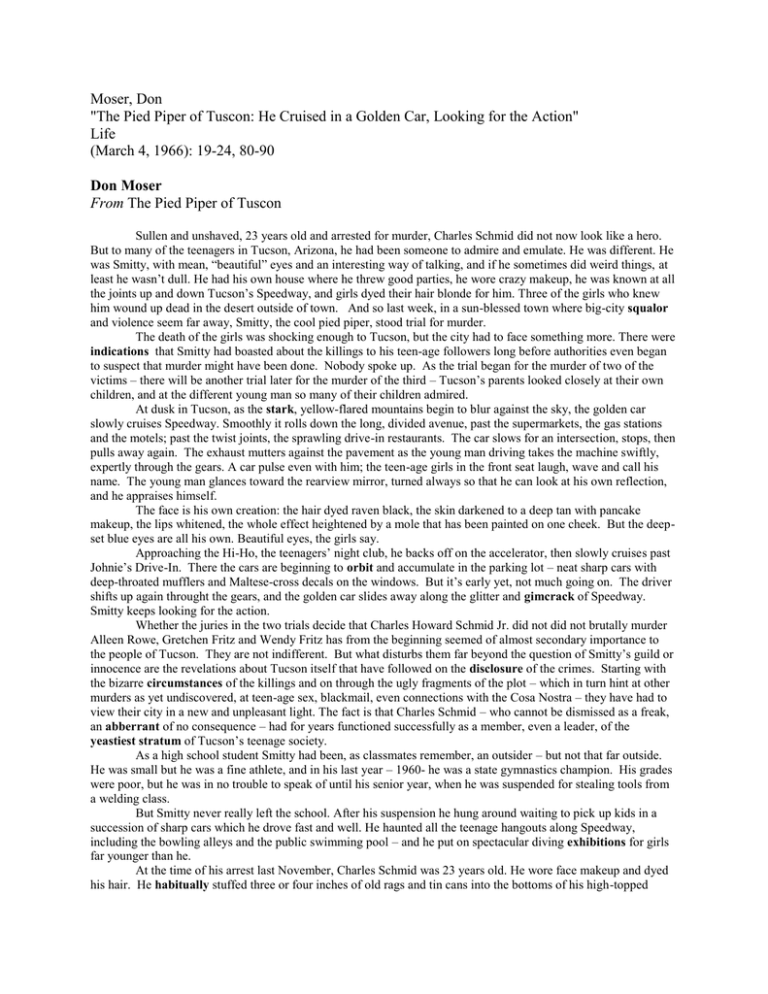
Moser, Don "The Pied Piper of Tuscon: He Cruised in a Golden Car, Looking for the Action" Life (March 4, 1966): 19-24, 80-90 Don Moser From The Pied Piper of Tuscon Sullen and unshaved, 23 years old and arrested for murder, Charles Schmid did not now look like a hero. But to many of the teenagers in Tucson, Arizona, he had been someone to admire and emulate. He was different. He was Smitty, with mean, “beautiful” eyes and an interesting way of talking, and if he sometimes did weird things, at least he wasn’t dull. He had his own house where he threw good parties, he wore crazy makeup, he was known at all the joints up and down Tucson’s Speedway, and girls dyed their hair blonde for him. Three of the girls who knew him wound up dead in the desert outside of town. And so last week, in a sun-blessed town where big-city squalor and violence seem far away, Smitty, the cool pied piper, stood trial for murder. The death of the girls was shocking enough to Tucson, but the city had to face something more. There were indications that Smitty had boasted about the killings to his teen-age followers long before authorities even began to suspect that murder might have been done. Nobody spoke up. As the trial began for the murder of two of the victims – there will be another trial later for the murder of the third – Tucson’s parents looked closely at their own children, and at the different young man so many of their children admired. At dusk in Tucson, as the stark, yellow-flared mountains begin to blur against the sky, the golden car slowly cruises Speedway. Smoothly it rolls down the long, divided avenue, past the supermarkets, the gas stations and the motels; past the twist joints, the sprawling drive-in restaurants. The car slows for an intersection, stops, then pulls away again. The exhaust mutters against the pavement as the young man driving takes the machine swiftly, expertly through the gears. A car pulse even with him; the teen-age girls in the front seat laugh, wave and call his name. The young man glances toward the rearview mirror, turned always so that he can look at his own reflection, and he appraises himself. The face is his own creation: the hair dyed raven black, the skin darkened to a deep tan with pancake makeup, the lips whitened, the whole effect heightened by a mole that has been painted on one cheek. But the deepset blue eyes are all his own. Beautiful eyes, the girls say. Approaching the Hi-Ho, the teenagers’ night club, he backs off on the accelerator, then slowly cruises past Johnie’s Drive-In. There the cars are beginning to orbit and accumulate in the parking lot – neat sharp cars with deep-throated mufflers and Maltese-cross decals on the windows. But it’s early yet, not much going on. The driver shifts up again throught the gears, and the golden car slides away along the glitter and gimcrack of Speedway. Smitty keeps looking for the action. Whether the juries in the two trials decide that Charles Howard Schmid Jr. did not did not brutally murder Alleen Rowe, Gretchen Fritz and Wendy Fritz has from the beginning seemed of almost secondary importance to the people of Tucson. They are not indifferent. But what disturbs them far beyond the question of Smitty’s guild or innocence are the revelations about Tucson itself that have followed on the disclosure of the crimes. Starting with the bizarre circumstances of the killings and on through the ugly fragments of the plot – which in turn hint at other murders as yet undiscovered, at teen-age sex, blackmail, even connections with the Cosa Nostra – they have had to view their city in a new and unpleasant light. The fact is that Charles Schmid – who cannot be dismissed as a freak, an abberrant of no consequence – had for years functioned successfully as a member, even a leader, of the yeastiest stratum of Tucson’s teenage society. As a high school student Smitty had been, as classmates remember, an outsider – but not that far outside. He was small but he was a fine athlete, and in his last year – 1960- he was a state gymnastics champion. His grades were poor, but he was in no trouble to speak of until his senior year, when he was suspended for stealing tools from a welding class. But Smitty never really left the school. After his suspension he hung around waiting to pick up kids in a succession of sharp cars which he drove fast and well. He haunted all the teenage hangouts along Speedway, including the bowling alleys and the public swimming pool – and he put on spectacular diving exhibitions for girls far younger than he. At the time of his arrest last November, Charles Schmid was 23 years old. He wore face makeup and dyed his hair. He habitually stuffed three or four inches of old rags and tin cans into the bottoms of his high-topped boots to make himself taller than his five-fo0t-three and stumbled about so awkwardly while walking that some people thought he had wooden feet. He pursed his lips and let his eyelids droop in order to emulate his idol, Elvis Presley. He bragged to girls that he knew 100 ways to make love, that he ran dope, that he was a Hell’s Angel. He talked about being a rough customer in a fight (he was, though he was rarely in one), and he always carried in his pocket tiny bottles of salt and pepper, which he said he used to blind his opponents. He liked to use highfalutin language and had a favorite saying, “I can manifest my neurotical emotions, emancipate an epicural instinct, and elaborate on my hetereosexual tendencies.” He occasionally shocked even those who thought they knew him well. A friend says he once saw Smitty tie a string to the tail of his pet cat, swing it around his head and beat it bloody against a wall. Then he turned calmly and asked, “You feel compassion – why?” Yet even while Smitty tried to create an exalted, heroic image of himself, he had worked on a pitiable one. “He thrived on feeling sorry for himself,” recalls a friend, “and making others feel sorry for him.” At various times Smitty told intimates that he had leukemia and didn’t have long to live. He claimed that he was adopted, that his real name was Angel Rodriquez, that his father was a “bean” (local slang for Mexican, and inferior race in Smitty’s view), and that his mother was a famous lawyer who would have nothing to do with him. What made Smitty a hero to Tucson’s youth? He had a nice car. He had plenty of money from his parents, who ran a nursing home, and he was always glad to spend it on anyone who’d listen to him. He had a pad of his own where he threw parties and he had impeccable manners. He was always willing to help a friend and he would send flowers to girls who were ill. He was older and more mature than most of his friends. He knew where the action was, and if he wore makeup – well, at least he was different. Some of the older kids – those who worked, who had something else to do – thought Smitty was a creep. But to the youngsters – to the bored and the lonely, the dropout and the delinquent, to the young girls with beehive hairdos and tight pants they didn’t quite fill out, and to the boys with acne and no jobs – to these people Smitty was a kind of folk hero. Nutty maybe, but at least more dramatic, more theatrical, more interesting than anyone else in their lives: a semi-ludicrous sexy eyed pied piper who, stumbling along in his rag-stuffed boots led them up and down Speedway…
